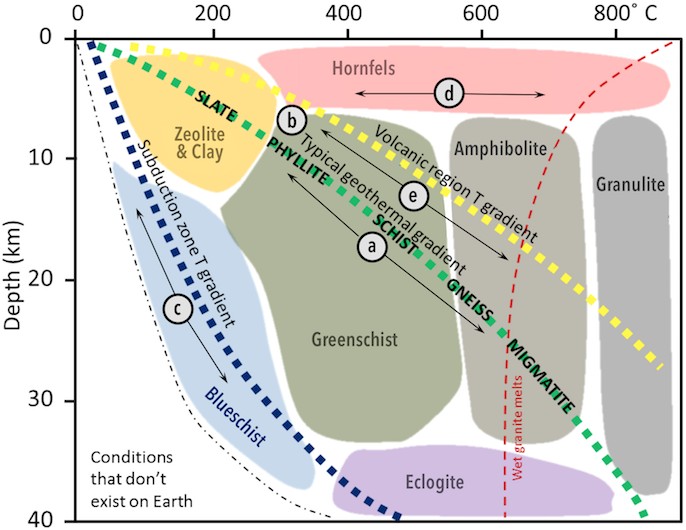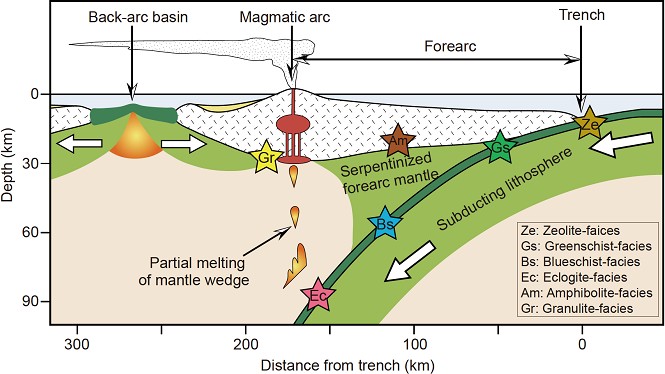7 Lab 7—Metamorphism and metamorphic rocks
WHAT ARE METAMORPHIC ROCKS?
Metamorphic rocks started out as some other type of rock, but have been substantially changed from their original igneous, sedimentary, or earlier metamorphic, form. Metamorphic rocks form when rocks are subjected to high heat, high pressure, hot mineral-rich fluids or, more commonly, some combination of these factors. Conditions like these are found deep within the Earth or where tectonic plates meet.
The process of metamorphism does not melt the rocks, but instead transforms them into denser, more compact rocks. New minerals are created either by rearrangement of mineral components or by reactions with fluids that enter the rocks. Pressure or temperature can even change previously metamorphosed rocks into new types. Metamorphic rocks are often squished, smeared out, and folded. Despite these uncomfortable conditions, metamorphic rocks do not get hot enough to melt, or they would become magma that could then crystallize to form igneous rocks.
Some kinds of metamorphic rocks—gneiss and schist are two examples—are strongly
banded or foliated. Foliated means the parallel arrangement of certain mineral grains
that gives the rock a striped appearance. Foliation forms when pressure squeezes the flat or elongate minerals within a rock so they become aligned. These rocks develop a platy or sheet-like structure that indicates the direction that pressure was applied.
Non-Foliated Metamorphic Rocks:
Non-foliated metamorphic rocks do not have a platy or sheet-like structure. There are several ways that non-foliated rocks can be produced. Some rocks, such as limestone are made of minerals that are not flat or elongate. No matter how much pressure you apply, the grains will not align! Another type of metamorphism, contact metamorphism, occurs when hot igneous rock intrudes into some pre-existing rock. The pre-existing rock is essentially baked by the heat, changing the mineral structure of the rock without addition of pressure. (from USGS, 2019b)
Table 7.1. Metamorphic rock identification table
|
Texture |
Grain size |
Appearance |
Type of Metamorphism |
Parent Rock |
Rock Name |
|
Foliate d |
Very fine |
Strong appearance of layering, smooth dull surface s |
Low-grade regional |
Shale, mudstone, or siltstone |
S late |
|
Fine |
Breaks along wavy surfaces, glossy sheen |
Intermediate-low- grade regional |
Shale , mudstone, or siltstone |
Phyllite |
|
|
Medium to coarse |
Large flakes of mica (biotite and muscovite) very common |
Intermediate-high- grade regional |
Shale , mudstone, or siltstone |
Mica Schist |
|
|
Medium to coarse |
Contains abundant talc, has a greasy feel, well- developed schistosity, often grayish-green color |
Intermediate-high- grade regional |
Igneous or carbonate talc- bearing bocks |
Talc Schist |
|
|
Medium to coarse |
Compositional banding due to segregation of mine rals |
High-grade regional |
Shale, mud-stone, siltstone, or granite |
Gneiss |
|
|
Non- foliate d |
Very fine |
Typically dull with a greenish color. May contain asbestos fibers |
Regional |
Mafic or ultramafic igneous rocks |
Serpentinite |
|
Fine |
Dark, dull, opaque colors ; dense, compact, conchoidal fracture |
Contact |
Any silicate rock type |
Hornfels |
|
|
Fine |
Shiny, black, may exhibit conchoidal fracture |
Regional |
Bituminous Coal |
Anthracite |
|
|
Medium to coarse |
Interlocking calcite or dolomite grains |
Regional or contact |
Limestone or Dolostone |
Marble |
|
|
Medium to coarse |
Translucent to pale colors , fused quartz grains, massive , very hard |
Regional or contact |
Sandstone |
Quartzite |
|
|
Coarse- grained |
Rounded or stretched pebbles that have a preferred orientation |
Regional |
Conglomerate |
Me ta- conglomerate |
|

Figure 7.1. Metamorphic facies and types of metamorphism shown in the context of depth and temperature. The metamorphic rocks formed from a mudrock protolith under regional metamorphism with a typical geothermal gradient are listed. Letters correspond to the types of metamorphism shown in Figure 7.2 (Panchuk, 2018).

Figure 7.2. Schematic diagram of a subduction zone illustrating the locations at which the various metamorphic facies (as shown in Figure 7.1) occur. Hornfels takes place in the zone of contact metamorphism immediately surrounding an igneous intrusion where the surrounding silicate rocks are literally baked (Strekeisen, 2020).
PART 1. Rock cycle synthesis: exploring rock-forming processes with playdough (adapted from The Reach Museum, n.d.)
For the first part of this lab activity, you will explore the responses (strains) of a material to forces (stresses). Any rock you find has been changed slowly over time because of various forces acting on it. Using playdough, you can model how rocks change from one type to another.
- Start with three different colors of playdough. You’ll only need a small amount of each. Imagine that these are three little igneous rocks sitting at the edge of a river. Over time these rocks will break down into smaller pieces by the action of weathering and erosion.
Simulate this by breaking your playdough into a lot of tiny pieces.
Analyze your clasts, considering Table 6.1 and Figure 6.3. What grain-size type are they? How rounded are they?
2. The tiny pieces of rock are called sediment. Sometimes these sediments stick together through a process called lithification. When this happens a sedimentary rock is created!
Gently press your playdough sediments together until they are sticking to each other but you can still see the individual clasts.
Using the sedimentary rock identification table (Table 6.2), what rock name would you give this?
3. Imagine that this sedimentary rock gets buried deep in the earth, perhaps in a subduction zone. It becomes subjected to intense pressure and heat. The different layers of sediment are squished together to create a new kind of rock. When this happens a metamorphic rock is created!
Use the heat and pressure of your hands to squish your playdough layers together.
a. Is this rock foliated or non-foliated?
b. Using the metamorphic rock identification table (Table 7.1), what rock name would you give this?
4. Now look at Figures 7.1 and 7.2. What metamorphic facies have you modeled during this activity?
5. What if your rock was buried even deeper? It might melt completely into magma. If that magma cools down again the igneous rock that forms will have mixed with other melted materials and transformed into a new rock.
Simulate melting your metamorphic rock into magma by squishing and folding your playdough rock together until it is all one color.
What might happen to your “rock” next?
Once that magma crystallizes to form a new igneous rock, any of these processes can happen again, transforming your rock into yet another sedimentary, metamorphic, or igneous rock. The rock cycle never stops.
PART 2. Complete the following chart for each of the metamorphic samples.
|
Sample |
Texture (Foliated or Non-foliated?) |
Protolith (Parent rock) |
Metamorphic Facies |
Rock Name |
|
1 |
|
|
|
|
|
2 |
|
|
|
|
|
3 |
|
|
|
|
|
4 |
|
|
|
|
|
5 |
|
|
|
|
|
6 |
|
|
|
|
|
7 |
|
|
|
|
|
8 |
|
|
|
|
|
9 |
|
|
|
|
|
10 |
|
|
|
|
|
11 |
|
|
|
|
REFERNCES
Panchuk, Karla, 2019, “6.2 The Rock Cycle,” in Physical Geology, First University of Saskatchewan Edition, https://openpress.usask.ca/physicalgeology/chapter/10-4- metamorphic-facies-and-index-minerals-2/; last access: 2022-07-06.
Strekeisen, Alex, 2020, “Blueschist,” https://www.alexstrekeisen.it/english/meta/blueschist.php; last access: 2022-07-07.
The Reach Museum, n.d., “Playdough Rock Cycle,” https://visitthereach.us/wp- content/uploads/2021/02/Playdough-Rock-Cycle-Activity-Sheet.pdf; last access: 2022-07-07.
United States Geological Survey (USGS), 2019b, “What Are Metamorphic Rocks?” https://www.usgs.gov/faqs/what-are-metamorphic-rocks-0?qt- news_science_products=0#qt-news_science_products; last access: 2019-09-03.
